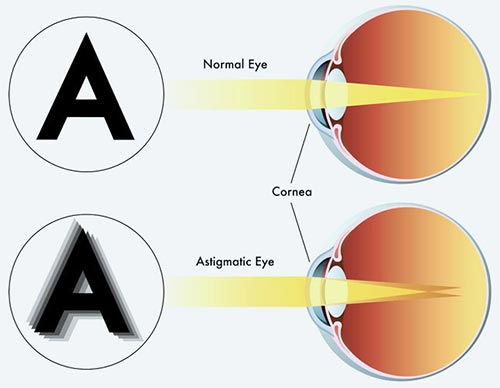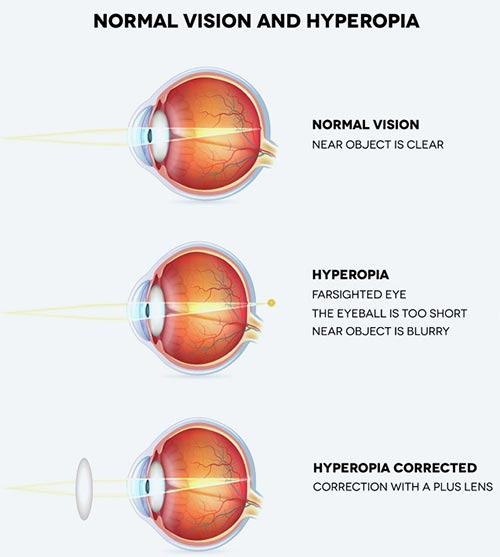Lazy Eye (Amblyopia)
 Amblyopia is the medical term for when a person’s vision quality in an eye is reduced because the brain and eye aren’t working together. The eye may look normal, but it isn’t being used properly because the brain is prioritizing the other eye. This condition is also referred to as lazy eye.
Amblyopia is the medical term for when a person’s vision quality in an eye is reduced because the brain and eye aren’t working together. The eye may look normal, but it isn’t being used properly because the brain is prioritizing the other eye. This condition is also referred to as lazy eye.
The most common cause of visual impairment among children is amblyopia. Two to three out of every 100 children are affected by lazy eye. And lazy eye persists into adulthood, unless it’s successfully treated. Amblyopia is also the most common cause of one eye (monocular) conditions among young and middle-aged adults.
If you are having any abnormal visual symptoms, you should always be evaluated with a thorough consultation and examination by a physician for an accurate diagnosis and treatment plan as it may be a symptom or sign of a serious illness or condition.
Causes of Lazy Eye
Lazy eye can be caused by any condition that prevents your eye from focusing properly. It can also be caused by your eyes being misaligned, a condition known as strabismus. In strabismus, the eyes cross inward (esotropia) or they can turn outward (exotropia). Occasionally, a cataract growth or clouding of your cornea and lens can cause amblyopia.
The most common cause of lazy eye is when one eye doesn’t focus as well as the other. Lazy eye or amblyopia can exist when one eye is more farsighted or nearsighted than the other, or when one eye has a greater astigmatism (an abnormal lens shape) than the other. This is called refractive amblyopia. Each of these terms (nearsighted, farsighted and astigmatism) refer to the ability of your eye to focus light on the retina in the back of the eye.
 Farsightedness (hyperopia) is when the distance from the back of the eye to the front is shorter than normal. Farsighted eyes tend to focus better at a distance, but don’t focus clearly on objects that are nearby. Nearsightedness (myopia) is a condition where the distance from the front of the eye to the back is too far. Nearsighted eyes tend to focus more accurately on objects nearby than further distances. Eyes with astigmatism don’t easily focus on objects near or far because of their abnormal shape.
Farsightedness (hyperopia) is when the distance from the back of the eye to the front is shorter than normal. Farsighted eyes tend to focus better at a distance, but don’t focus clearly on objects that are nearby. Nearsightedness (myopia) is a condition where the distance from the front of the eye to the back is too far. Nearsighted eyes tend to focus more accurately on objects nearby than further distances. Eyes with astigmatism don’t easily focus on objects near or far because of their abnormal shape.
Symptoms of Lazy Eye
The most common symptom of lazy eye is an eye that wanders outward or inward. Other common symptoms include:
- Eyes that don’t work well together
- Squinting
- Shutting one eye
- Tilting your head to better see
- Poor depth perception
- Abnormal vision screening tests
Sometimes, lazy eye isn’t apparent until your eye care professional conducts an eye exam. There are also risk factors associated with the condition of lazy eye that, if they apply to you or your child, should prompt you to seek a regular eye exam. These include:
- Premature birth
- Family history of lazy eye
- Developmental disabilities
- Small size at birth
If lazy eye goes untreated, it can result in permanent vision loss in the affected eye. According to the Mayo Clinic, 2.9 percent of adults with lazy eye experience permanent loss of vision. If you are having any visual abnormalities you should always be evaluated with a thorough consultation and examination by a physician for an accurate diagnosis and treatment plan as it may be a symptom or sign of a serious illness or condition.
Diagnosis for Lazy Eye
It’s not easy for parents to detect lazy eye in their children. Children might not be aware that they have one eye stronger or weaker than the other. Unless the eye is misaligned or an abnormality is obvious, there’s no way to tell something is wrong without visiting your ophthalmologist.
Amblyopia is detected by determining a difference in vision between your eyes — or poor vision in one or both eyes. Measuring vision in young children is difficult, but pediatric ophthalmologists are experienced at it. Other New York ophthalmologists often watch how children and babies react when one eye follows an object while the other is closed. Another test involves covering one eye and then the other with a patch. If the strong eye is covered and amblyopia is present, the baby may attempt to look around the patch, start crying or attempt to pull the patch off.
If children have poor vision in one eye, it doesn’t always mean they have amblyopia. Their vision may be improved with eyeglasses. Your ophthalmologist also examines your child for other eye diseases and conditions including cataracts, tumors, inner eye problems and inflammation.
Lazy Eye Treatment
Treating lazy eye often involves asking the child to use the eye that has weaker vision. The two common ways to treat lazy eye include patching and atropine.
- Patching: For patching to work, an adhesive patch is placed over the stronger eye for a duration lasting a few weeks to a couple months. This forces the child to use the eye with poorer vision (the eye with amblyopia). Patching therapy stimulates vision in the afflicted eye, and it helps the brain properly develop vision.
A National Eye Institute (NEI) study reports that patching the strong eye of a child for two hours a day works as well as patching it for six hours a day. Children who are patched for a shorter duration comply with the treatment better, and they have an improved quality of life. It was also found that when children don’t show improvement, increasing the patching time to six hours a day results in improvement of the condition for those children.
Previously, the conventional thinking was that amblyopia treatment would have little effect on older children. However, in another NEI study, children aged seven to 17 benefited from the patching treatment. This study proved that age alone should not be the determining factor in using patching therapy.
- Atropine: Instead of a patch, a drop of a prescription medicine called atropine is placed in the stronger eye to blur it, so the child is forced to use the weaker eye. The research from this study showed that atropine drops work as well as patching and may be easier for parents and the child to use.
As for amblyopia treatment in adults, studies are very limited. Scientists are unable to determine the success rate and effectiveness for treating lazy eye in adults. One of the reasons for this is that a large part of the effectiveness of amblyopia treatment in children has to do with the treatment of the brain. The visual system grows at a rapid pace during the first seven to 10 years of life. Important connections with the eye and brain are forged during this development. As of 2016, studies are still being conducted that are exploring treatments for adults with amblyopia.
If you are having any abnormal visual symptoms, you should always be evaluated with a thorough consultation and examination by a physician for an accurate diagnosis and treatment plan as it may be a symptom or sign of a serious illness or condition.
Important Reminder: This information is only intended to provide guidance, not a definitive medical advice. Please consult eye doctor about your specific condition. Only a trained, experienced board certified eye doctor can determine an accurate diagnosis and proper treatment.
Do you have any questions about Lazy Eye (Amblyopia) procedure in NYC? Would like to schedule an appointment with top ophthalmologist in NYC, Optometrist Dr. Saba Khodadadian of Manhattan Eye Specialists, please contact our office for consultation with NY eye doctor.
Dr. Saba Khodadadian, Optometrist (NYC Eye Doctor)
New York, NY 10028
(Between Madison Ave & Park Ave)
☎ (212) 533-4821


